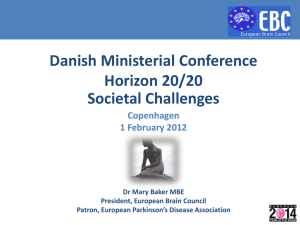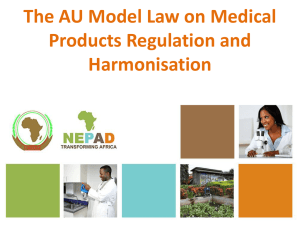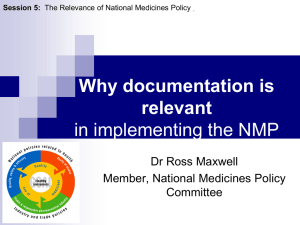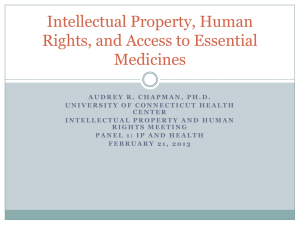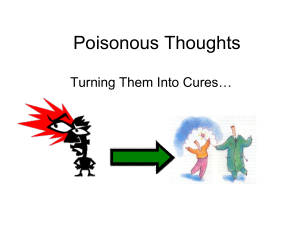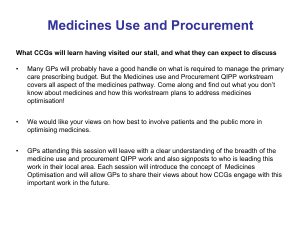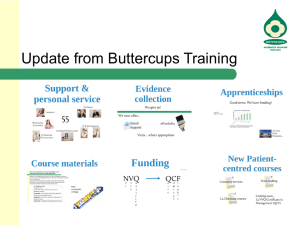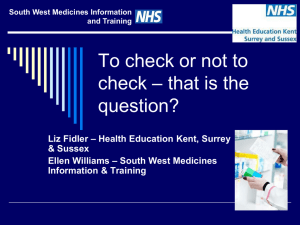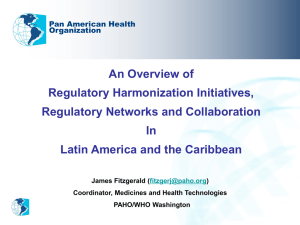1307-Fitzgerald-_b
advertisement
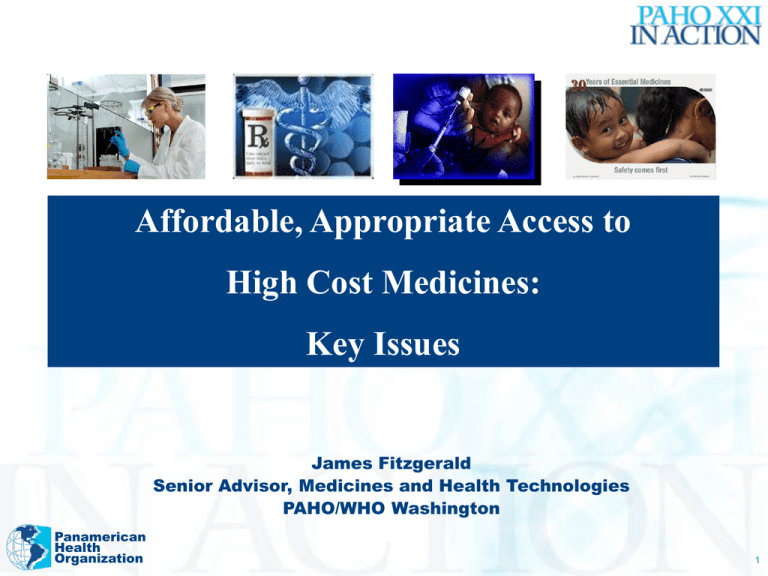
Affordable, Appropriate Access to High Cost Medicines: Key Issues James Fitzgerald Senior Advisor, Medicines and Health Technologies PAHO/WHO Washington Panamerican Health Organization 1 Context in the Americas • • • • • • 218 million lack social security in health LAC expenditures (2008) estimated at US$ 73 bn, equivalent to 23% of National Health Expenditure in goods and services Out of Pocket Expenditure (OOP) of 78% (7.5 USD – 150USD) Fragmentation and segmentation leading to persistent inequities 92% of countries have updated EMLs: however the number of medicines considered ‘essential’ varies from 346 to over 650 Patent expirations in the US in 2011/2012 offset by introduction of newest biotechnologies (Brazil 4%, China 24%) Panamerican Health Organization 2 Pharmaceutical expenditure lower middle income countries AMRO (Evolution on Q1 08) 1.20 1.17 1.15 1.12 1.10 1.05 1.05 1.00 1.00 0.98 0.95 0.96 0.90 0.90 0.88 0.86 0.85 0.80 0.75 0.78 Q1 07 Q2 07 Q3 07 C. AMERICA * (Mul tpl Cty) Panamerican Health Organization Q4 07 Q1 08 COLOMBIA* Q2 08 ECUADOR* Q3 08 Q4 08 PERU* Q1 09 Q2 09 AMRO AVERAGE 3 Judicial interventions to ensure Access to Medicines: the case of Minas Gerais, Brazil, (2005 – 2006) • Study (Machado et al. 2011 ) examining 827 legal actions involving 1,777 medicines during 2005 and 2006. • Origin: 70% from the private sector, and 60 % from individuals (as opposed to class actions). • Results: – Appx. 5% of the solicited medicines not approved by the ARN, Anvisa. – 79% of the medicines requested had a defined therapeutic alternative within the national health programs (Assitencia Farmaceutica). • Conclusions: Whereas judicial actions can guarantee the right to health, they also: – Can produce distortions in the practice of the rational use of medicines – Represent a threat to the National Health System (SUS), the consolidation of the National Pharmaceutical Policy. Panamerican Health Organization 4 Characteristics of High Cost Medicines • No universal definition • Conceptual elements of the approach are similar: – High priced essential medicines, limited or single source (exclusivity) – Specialized medicines for specific or rare diseases, associated with costly and complex health interventions – Long term chronic disease care and management • Representing an ever increasing (absolute and relative) portion of pharmaceutical expenditure Panamerican Health Organization 5 A question of Innovation? • Market driven R&D is not responding to needs in innovation for health technologies. • The degree of value-added…..? The evidence base….? • Public health perspective calls for clear therapeutic benefits and/or lower cost: – Comparable to existing treatments – Based on needs of the society • The need for the development of integrated national strategies with the following Actions: Panamerican Health Organization 6 1. Innovation in Pharmaceutical/HT Policy Health Policy Pharmaceutical /HT Policy Science & Technology Policy Panamerican Health Organization •Defining innovation strategies based on public health needs •Promotion of mechanisms for R&D and knowledge transfer •Increase capacity in the production chain •Ensuring inter-ministerial coordination •Public Health management of IP Industrial Policy 7 2. Evaluation and Incorporation of Health Technologies • Health Technology Assessment (HTA): Using evidence for the decision making process / incorporation within the health system • Important trends in the Americas: – – – – Argentina: creation of a Coordination Unit (UCEETS), sectoral funds. Colombia: new HTA institute to be created Uruguay: mandatory EE for medicines to be covered by FNR Brazil: Price Regulation based on HTA; new Federal Law to regulate health technology incorporation to the Public Health System – Subregional networks in Andean and Mercosur Regions • Policy discussion with Resolution requested by Member States, PAHO Governing Bodies 2012. Panamerican Health Organization 8 2. HTA Network of the Americas (RedETSA) • Launched June 2011, 20 institutions from 13 countries (Argentina, Bolivia, Brazil, Canada, Chile, Colombia, Costa Rica, Cuba, Ecuador, Mexico, Paraguay, Peru, Uruguay), with PAHO technical support: • Work Plan: – HTA Community of Practice; regional dialogue on national and global experiences. – regional diagnostic on HTA and decision-making processes; – joint studies; capacity building; Network meetings; publications • Cooperation agreements with MOH Brazil/Anvisa (2010), Canadian Medicines and Health Technologies Agency (CADTH 2011). Panamerican Health Organization 9 3. Linkages with Procurement and Financing • Pricing transparency through publicly available pricing data systems (generic and single/limited source) • Relationship between HTA and: – processes for price regulation (price referencing, value-added) – medicines financing (selective financing, adjusting co-payment modalities). • Centralized negotiations for High Cost Medicines with consolidated public sector procurement • Evaluate options through international mechanisms (PAHO Revolving Fund for Vaccines, PAHO Strategic Fund). Panamerican Health Organization 10 4. Promote and Regulate Rational Use • Strict application of treatment protocols and guidelines for high cost medicines • Promote incentives for rational prescribing: eliminate perverse incentives • Training of prescribers and pharmacists supported with independent and reliable information • Role of ARN in Rational Use Panamerican Health Organization 11 Contact: James Fitzgerald fitzgerj@paho.org Panamerican Health Organization www.paho.org 525 23rd St NW Washington DC 20037 USA Panamerican Health Organization 12
